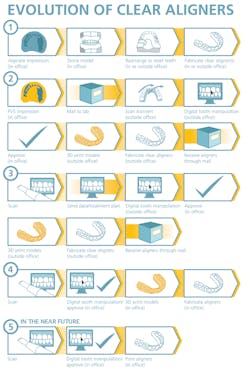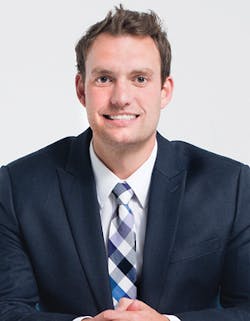Clear aligners: Technology versus physiology
Mark Causey, DMD
While the physiological mechanisms responsible for tooth movement have remained unchanged, clear aligner therapy for the treatment of malocclusions is more efficient and more predictable than ever. What’s driving the progress? Technology.
The precursor to clear aligners was introduced in orthodontics by H. D. Kesling more than 60 years ago (figure 1). Because computers and 3-D printing were not available at the time, Kesling would simulate alignment and occlusion by rearranging teeth to an ideal position and occlusion on a stone model. He would then fabricate the tooth-positioner appliance.1 If worn properly, the appliance would place an adequate amount of force to move the teeth into the simulated position.
Figure 1: Evolution of clear aligners
As materials advanced and thermoformed plastics became more widely available in orthodontics, clear aligner therapy began to take shape. Jack Sheridan used clear retainers that he termed Essix retainers to apply force to teeth to make minor tooth movements.2 He developed techniques such as air rotary stripping and Essix “mounding,” that would lead to the improvement of clear aligner predictability and effectiveness.3,4 Today, these two techniques are commonly referred to as interproximal reduction and aligner attachments.
Although there were improvements, aligner fabrication was technique-sensitive and often carried out in the dental office or by an orthodontic lab. As computers and the internet became more widely available to individuals and small businesses, information and data became easy to transfer and communicate, which led to the enormous growth of orthodontic clear aligner therapy.
Technological advancements and changes are exponential in nature rather than linear. Ray Kurzweil noted in a 2001 essay: “[…]we won’t experience 100 years of progress in the 21st century—it will be more like 20,000 years of progress (at today’s rate).”5 Advancements in orthodontic clear aligner therapy are a prime example of Kurzweil’s prediction.
A significant development that allowed this change was the ability to transfer anatomical dental variations to digital data. This data could then be manipulated remotely by an orthodontist and a technician, and then physically reproduced through 3-D printing. This capability allowed for the accurate, sequential movement of teeth and made clear aligner therapy a more comprehensive treatment option.
Despite the advances, the anatomical variation required traditional impressions that were mailed to be scanned and converted to digital data. Impressions were the bridge between physical and digital information that introduced inaccuracies and created delays between the transfer of information. These problems were solved with the introduction of the intraoral scanner.
Intraoral scanners have given orthodontists the ability to instantly convert anatomical information to digital data. Scanning has many advantages; however, clear aligner therapy has seen most of the associated benefits. Scanners have eliminated the shortcomings of impressions as well as provided the ability to instantly transfer and manipulate data.
Unfortunately, though, orthodontists quickly noticed interruptions in workflow. Slow scanning times were the culprit of the workflow disruption, but improvements in technology soon alleviated the problem. Scanning became faster and increased workflow efficiency, enabling offices to use scanners and capitalize on the benefits associated with clear aligner therapy.
Our office has used several scanners over the years, including the CS 3600 intraoral scanner from Carestream Dental. We have found it to be advantageous for its speed, accuracy, ability to scan in color, ease of use, and size, which enables the capture of difficult areas such as second molars. Another advantage is its ability to easily export intraoral scan files. Once the scan is obtained, the open source file can be exported to the lab or the CAD/CAM software of choice.
Orthodontic offices that use intraoral scans can also view and manipulate the data with their software. Tooth movement/manipulation software has improved dramatically, and it allows the orthodontist to transfer the intraoral scan and directly manipulate tooth movements without the assistance of a technician. Once the desired tooth position is achieved, the files can be exported to an orthodontic lab or directly printed using an in-office 3-D printer. After the models are printed, clear aligners can be fabricated using thermoformed plastics. In-office 3-D printers have become increasingly popular in orthodontic offices as a way to increase efficiency. Our 3-D printer has the ability to print multiple models relatively quickly and accurately.
As long as our schedule allows it, we manage and print limited clear aligner cases (10 or fewer), but we find it is more efficient to handle more comprehensive cases with the help of an outside lab. Perhaps as technology advances—and as we gain more experience with technology—we will be able to manage these cases entirely in-office.
I am confident that the future growth of technology will enable orthodontists to maintain and produce as many clear aligners as they desire—without the use of 3-D printed models. The orthodontic office of the future will have multiple 3-D printers, which will become the lab. Instead of printing models, orthodontists will be printing aligners and continuing the trend of eliminating steps and increasing efficiency.
Conclusion
In an unbelievably short amount of time, technology has improved the accuracy and efficiency of clear aligner therapy. As orthodontists, we are streamlining the process by eliminating steps and effectively predicting tooth movements using aligners. However, some things will remain unchanged. Technology will not eliminate the need to create effective treatment plans for malocclusion. Despite multiple attempts to alter tooth movement physiology, advances have not been as effective. We will continue to see technological advances to increase aligner accuracy and productiveness, but will it be able to overcome a rate-limiting factor of treatment time—the physiology behind tooth movement? Only time will tell.
MARK CAUSEY, DMD, a board-certified orthodontist from Gainesville, Georgia, received his orthodontic certificate from the Medical College of Georgia, Department of Orthodontics, in 2012. He recently received the North Georgia Young Alumnus Award in recognition for his outstanding professional achievements, public service, and exemplary loyalty to the university. A past president of the Georgia Orthodontists Foundation, Dr. Causey owns two practices in North Georgia.
References
1. Kesling HD. The diagnostic setup with consideration of the third dimension. Am J Orthod. 1956;42(10):740-748.
2. Sheridan JJ, Ledoux W, McMinn R. Essix appliances: minor tooth movement with divots and windows. J Clin Orthod. 1994;28(11):659-664.
3. Sheridan JJ. Air-rotor stripping update. J Clin Orthod. 1987;21(11):781-788.
4. Sheridan JJ, Armbruster P, Nguyen P, Pulitzer S. Tooth movement with Essix mounding. J Clin Orthod. 2004;38(8):435-441.
5. Kurzweil R. The law of accelerating returns. Kurzweil website. http://www.kurzweilai.net/the-law-of-accelerating-returns. Published March 7, 2001.


